Arctic Accelero TWIN TURBO II and Accelero XTREME Plus II Review

Today we will discuss the features, functionality, acoustic performance and efficiency of new modifications of the popular VGA coolers from a well-known Swiss ARCTIC Company.
As part of its expansion policy, the Swiss Arctic Cooling HK Ltd. has recently added speaker systems, various accessories and even ship and tank models to its product range. Fortunately, they haven’t forgotten about GPU cooling systems they have always been so good at, as opposed to CPU coolers. Recently Arctic Cooling has introduced two new modifications of its older designs: Accelero Twin Turbo II and Accelero Xtreme Plus II. Let’s learn more about them right now!
Accelero Twin Turbo II
Despite its name, the Accelero Twin Turbo II is a third modification of the Twin Turbo design which first came out in 2008 and isn’t manufactured anymore. In early 2010 it was replaced with the improved Twin Turbo Pro that had larger fans, more heatsink fins and broader compatibility. You can buy that elegant and light model even today for about $47. That’s why the new Twin Turbo II is actually third.
The cooler is shipped in a transparent blister wrap with a paper insert.
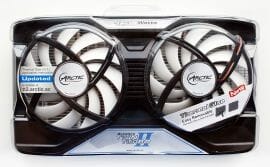
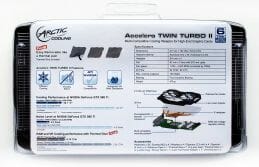
This packaging provides a free view of the face side of the product. You can also study the cooler’s specs and key features on the back of the insert. The Twin Turbo II is accompanied with quite a lot of accessories:
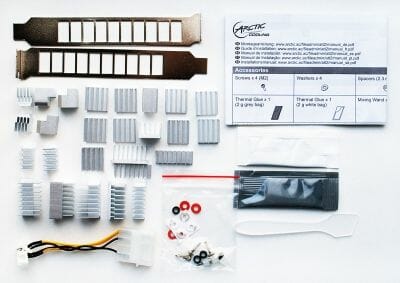
There are more aluminum heatsinks for memory chips and power components than in the Pro version. You also get dual-component thermal glue Arctic G-1 and a plastic spatula for preparing and applying it. This is a welcome change since the thermal tape that used to be included with the earlier Arctic products could only be used once and didn’t hold the heatsinks on the chips well enough.
The Twin Turbo II is manufactured in China and comes at a recommended price of $65.95. The warranty period is 6 years. No other maker of coolers provides such a long warranty for his products.
Compared to the previous version, the Accelero Twin Turbo II looks bulkier, even though it has only become longer by 2 millimeters, taller by 7 millimeters and wider by a mere 1 millimeter. Its dimensions are 215 x 122 x 53 millimeters and its weight is 479 grams, which is 29 grams heavier than that of the Pro version of the original Twin Turbo. The whole thing looks massive due to the broad plastic casing with fans that covers the face side of the heatsink.
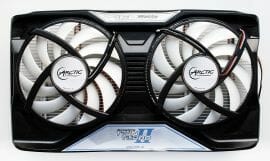
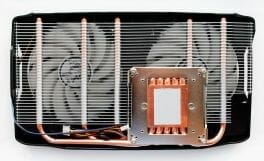
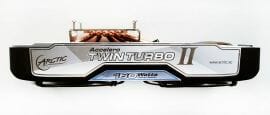
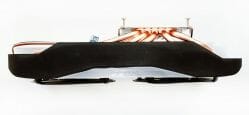
There’s a sticker with the product name on the casing. The peak power dissipation the Twin Turbo II can cope with is indicated beneath. It’s 160 watts. This differs from the official specs which mention 250 watts. We don’t know which number is true since we don’t have appropriate measuring tools. The Accelero Twin Turbo Pro was specified to dissipate up to 120 watts of heat, by the way.
The cooler’s heatsink is exceedingly simple but features five rather than four copper heat pipes with a diameter of 6 millimeters. There are still 35 aluminum fins in the heatsink.
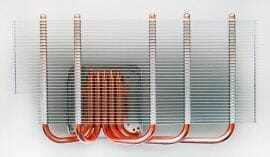
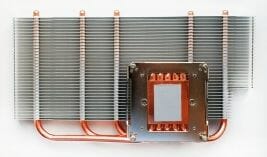
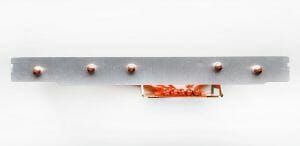
Press-fitted on the pipes, the fins are 0.4 millimeters thin and 2 millimeters apart from each other. There is a cutout in the bottom left of the heatsink to make it compatible with modern AMD-based graphics cards which have DVI outputs there. The heatsink has a total area of 2870 square centimeters.
The heat pipes are fitted into and soldered to the grooves in the cooler’s base.
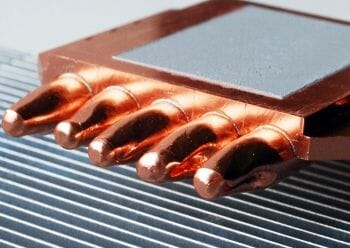
The base is finished to a mirror shine and has Arctic MX-4 thermal grease pre-applied.
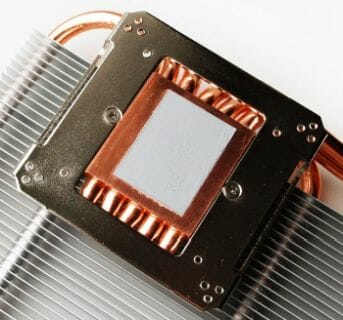
There was too much of the grease, though. We guess it would be better to have a small syringe of MX-4 as an accessory for the user to apply it himself. The cooler’s base is 36×33 millimeters large.
We removed the pre-applied grease and then put the necessary amount of MX-4 out of our own syringe. Here are the imprints that we got:
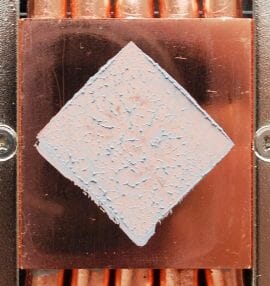
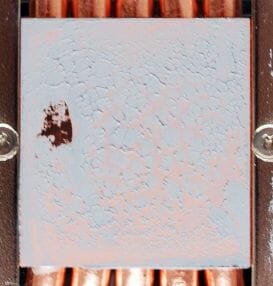
The diameter of the impellers and motors of these 11-blade fans is 87 and 33 millimeters, respectively. You can learn the electrical specs of the fans on their labels.
The speed of the fans is PWM-regulated within a range of 900 to 2000 RPM. The bottom noise level is specified to be 0.5 sones. The fluid dynamic bearing has a service life of 6 years. The peak power draw of each fan is no higher than 1.8 watts. The combined power consumption of both fans is below 2.9 watts according to our measurements.
You can connect the fans to a 3- or 4-pin connector on your graphics card or to your PSU’s PATA power connector (using the included 12/7V adapter).
Having four screw holes in each corner of the mounting frame, the Twin Turbo II is compatible with a lot of graphics cards, both modern and ancient ones.
You can also move the mounting frame along the cooler’s base using the three threaded holes.This allows adjusting the cooler’s base to match the GPU location on the particular graphics card. The distance between the center of the cooler’s base and its left (shorter) edge is 80 millimeters.
The installation procedure is most simple. You just fasten the cooler with screws from the reverse side of the graphics card using the included bushings. To make the procedure even simpler, you may want to take the plastic casing with fans off the heatsink and install the latter first.
Then you just hang the casing onto the heatsink, locking the latches at the sides.
The photo above shows the Accelero Twin Turbo II installed on an MSI Radeon HD 6950 Twin Frozr III 1GD5 Power Edition/OC which is as long as 242 millimeters. As you can see, the cooler is long enough for the entire card. It may turn out to be too short if installed on a longer card, though. For example, on a Gigabyte GeForce GTX 580 SuperOverclock which has a length of 277 millimeters.
It is for such long cards that the other new product from Arctic Cooling is designed for, though. Winding up this section, we can only tell you that the installed Twin Turbo II blocks the neighboring PCI slot. It is also desirable that the next expansion slot were free, too.
Accelero Xtreme Plus II
The Accelero Xtreme Plus II is shipped in a plastic blister wrap with paper inserts that promise a 27°C lower temperature at only one sixth of the reference cooler’s noise.
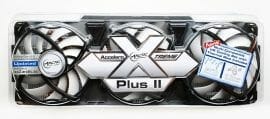
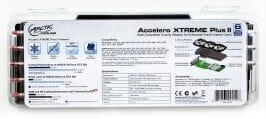
This model comes with the same accessories as the Accelero Twin Turbo II. The warranty period and country of origin are the same, too, but its recommended price is higher at $99.95.
The Accelero Xtreme Plus II looks similar to the Accelero Xtreme Plus and Accelero Xtreme 5870, having three 92x10mm fans and a bipartite heatsink with five 6mm copper heat pipes going through the copper base.
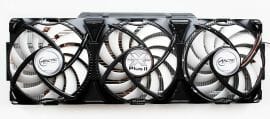
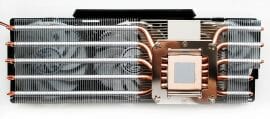
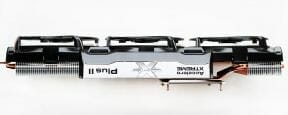
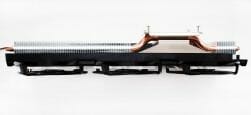
The Accelero Xtreme Plus II is declared to cope with up to 300 watts of heat whereas its predecessor Accelero Xtreme Plus could only deal with 250 watts. The newer model has fewer heatsink fins (84 instead of 83) and the same speed of the fans, so the increased efficiency must be due to some improvements in the heat pipe design or merely a marketing trick. Considering that Arctic doesn’t mention any innovations in the product description, this must be pure advertising.
The cooler is 288x103x50 millimeters; its weight is 615 grams. Its heatsink consists of two types of aluminum fins: 77 fins the size of 92×21 mm and 6 fins the size of 60×21 mm. They are press-fitted on the heat pipes 1.8 millimeters apart from each other.
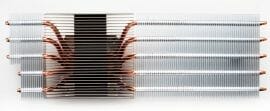
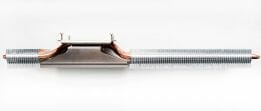
The fins are 0.3 millimeters thin, just like in the previous version of the cooler. The heatsink has a total area of 3070 square centimeters. There’s an auxiliary 95x92mm aluminum heatsink right above the cooler’s base. It helps take heat off the top part of the pipes.
The heat pipes are placed 12 to 13 millimeters apart from each other within the heatsink.
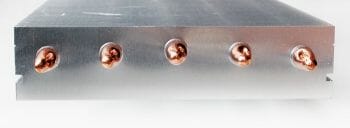
The pipes are neatly soldered to the base.
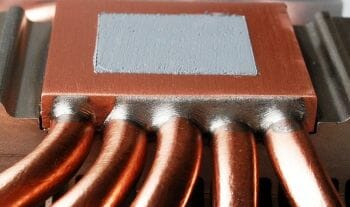
The Accelero Xtreme Plus II has a larger base (36×36 mm) than the Accelero Twin Turbo II, but its finish quality is lower. But it’s flat, as opposed to the GF100’s heat-spreader.
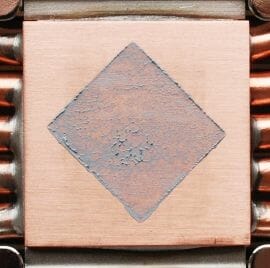
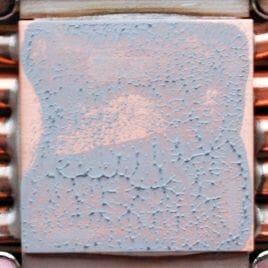
The Accelero Xtreme Plus II comes with the same fans as the Accelero Twin Turbo II:
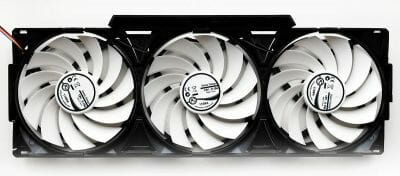
However, it has one fan more and the bottom speed is 1000 rather than 900 RPM. The other characteristics of the fans are the same.
The cooler is installed on a graphics card by means of a steel mounting frame.
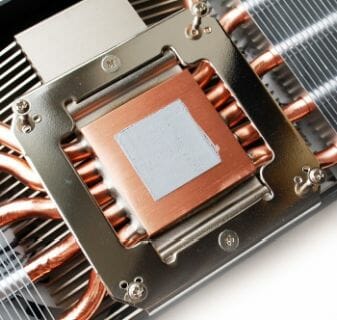
It has only three threaded holes in each corner, so the list of compatible graphics cards is not as long as that of the Accelero Twin Turbo II.
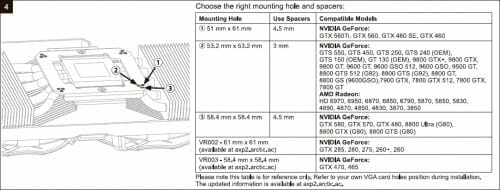
It’s simple to install this cooler. You just have to insert four screws from the reverse side of the card and tighten them.
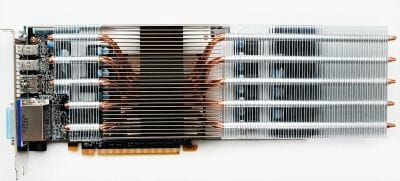
We must confess the Accelero Xtreme Plus II looks somewhat awkward on the short MSI Radeon HD 6950 Twin Frozr III 1GD5 Power Edition/OC card.
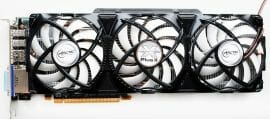
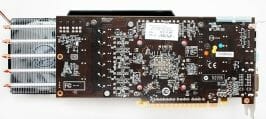
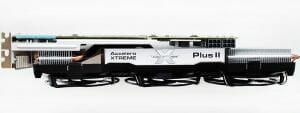
The third fan hangs down from the back edge of the card, blowing at nothing. On the other hand, the Accelero Xtreme Plus II is a perfect choice for such long cards as Gigabyte GeForce GTX 580 SuperOverclock, especially in terms of efficiency and noisiness as you will see shortly. We can only add that the distance from the center of the cooler’s base to the left (shorter) edge is 93 millimeters.
Testbed and Methods
The tests were performed in a closed system case. Our testbed was configured as follows:
- Mainboard: Gigabyte GA-X58A-OC (Intel X58 Express, LGA 1366, BIOS F5c from 9/6/2011);
- Processor: Intel Core i7-980X Extreme Edition, 3.33 GHz, 1.225 V, 6 x 256 KB L2, 12 MB L3 (Gulftown, B1);
- CPU cooler: Thermalright Archon (TY-140, 600-1260 RPM);
- Thermal interface: ARCTIC MX-4;
- Memory: DDR3 3 x 2 GB OCZ Platinum Low-Voltage Triple Channel (Spec: 1600MHz / 7-7-7-24 / 1.65 V);
- Graphics cards:
- MSI Radeon HD 6950 Twin Frozr III 1GD5 Power Edition/OC, 1 GB/256 bit, 940/5600 MHz;
- Gigabyte GeForce GTX 580 Super Overclock, GDDR5, 1.5 GB/384 bit, 930/1860/4400 MHz;
- System drive: RAID-0 of 2 x Kingston V-series SNV425S2128GB SSD (SATA-II, 128 GB, MLC, Toshiba TC58NCF618G3T controller);
- Drive for programs and games: Western Digital VelociRaptor (300GB, SATA-II, 10000 RPM, 16MB cache, NCQ) inside Scythe Quiet Drive 3.5” HDD silencer and cooler;
- Backup drive: Samsung Ecogreen F4 HD204UI (SATA-II, 2 TB, 5400 RPM, 32 MB, NCQ);
- System case: Antec Twelve Hundred (front panel: three Noiseblocker NB-Multiframe S-Series MF12-S2 fans at 1020 RPM; back panel: two Noiseblocker NB-BlackSilent PRO PL-1 fans at 1020 RPM; top panel: standard 200 mm fan at 400 RPM);
- Control and monitoring panel: Zalman ZM-MFC2;
- Power supply: Xigmatek “No Rules Power” NRP-HC1501 1500 W (with a default 140 mm fan).
Both graphics cards are equipped with unique cooling systems boasting higher efficiency and lower noise than the corresponding reference graphics card coolers.
We are going to compare the cooling efficiency and acoustic performance of the new Arctic offerings against these two products. We increased the GPU and graphics memory frequencies in order to increase the graphics cards heat dissipation and make the testing conditions more challenging for our today’s participants.
The testing programs were installed under Microsoft Windows 7 Ultimate x64 SP1. We used DirectX End-User Runtimes libraries (from November 2010), as well as AMD Catalyst 11.9 and Nvidia GeForce 285.38 beta graphics card drivers. We used five runs of Aliens vs. Predator game in 1920×1080 resolution and with maximum image quality settings, 16x anisotropic filtering and 4x antialiasing to warm up the graphics accelerators.
With the settings we used this test loads even a powerful graphics accelerator very heavily, but can’t damage it, which could be the case with FurMark (that is why we decided not to use this benchmark fully in our test session). Nevertheless, we tested both graphics cards at maximum fan speeds of both Arctic coolers in FurMark version 1.9.1 with the following settings.
We used MSI Afterburner utility version 2.2.0 Beta 8 to monitor graphics card temperatures and frequencies and GPU-Z version 0.5.5 utility.
The tests were run at least twice. The temperature stabilization period between the two test cycles was about 10-12 minutes. The ambient temperature was checked next to the system case with an electronic thermometer with 0.1°C precision that allows monitoring the temperature changes over the past 6 hours. During our test session room temperature stayed around 24.6-25.0°C. We used our in-house controller to adjust the rotation speed of all cooler fans except for the Gigabyte graphics card.
The noise level of each cooler was measured between 1:00 and 3:00 AM in a closed room about 20 m2 big using CENTER-321 electronic noise meter. The noise level for each cooler was tested outside the system case when the only noise sources in the lab were the cooler and its fan. The noise meter was installed on a tripod and was always at a 150 mm distance from the cooler fan rotor. The tested cooling systems were placed at the edge of the desk on a sheet of polyurethane foam. The lowest noise reading our noise meter device can register is 29.8 dBA and the subjectively comfortable noise level in these testing conditions was around 36 dBA (do not mix it up with low noise level).
Now let’s check out the results of our tests.Performance
Cooling Efficiency Tests
First, let’s see how the new coolers from Arctic Cooling are going to cope with an overclocked MSI Radeon HD 6950:
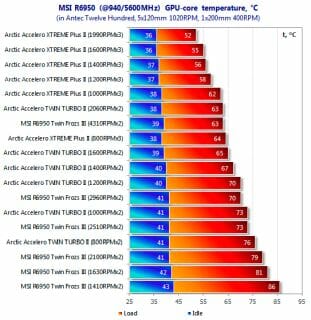
The Xtreme Plus II and Twin Turbo II differ greatly in performance. For example, working at the maximum speed of 2060 RPM, the Twin Turbo II is 1°C worse than the Xtreme Plus II at a quiet 1000 RPM. The latter cooler is beyond competition in this test, actually. We can note that its performance scales up depending on the speed of its three fans. Each extra 200 RPM of speed lowers the GPU temperature by 2-3°C. What is especially impressive, the Xtreme Plus II is as effective at cooling the GPU at its minimum 800 RPM as the original MSI Twin Frozr III cooler at its maximum 4310 RPM!
Although inferior to its senior cousin, the Accelero Twin Turbo II easily beats the original MSI cooler, too. Working at 800 RPM, it is 3°C better than the MSI Twin Frozr III at 2100 RPM. At 1000 RPM it’s as good as the MSI at 2510 RPM. Running a little ahead, we can tell you that the Accelero Twin Turbo II is also way better than the MSI Twin Frozr III in terms of noisiness.
Now what about FurMark? Can the new Arctic coolers cope with such a high load? Yes, they can:
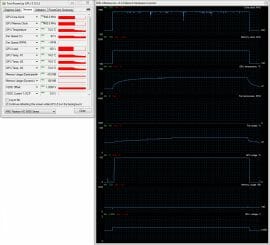
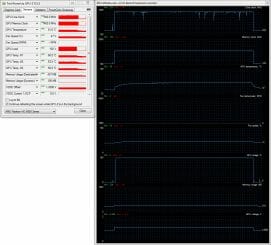
The overclocked GPU of our MSI Radeon HD 6950 was only 74°C hot with the Twin Turbo II at 2060 RPM and 61°C hot with the Xtreme Turbo II at 1990 RPM. The more advanced model is 13°C more efficient under the extremely high FurMark load. The GPU monitoring graph indicates that the GPU clock rate would occasionally go down, even though the appropriate setting in the Catalyst driver was set at +20%.
Now let’s test the new coolers with a faster and hotter Gigabyte GeForce GTX 580 SuperOverclock:
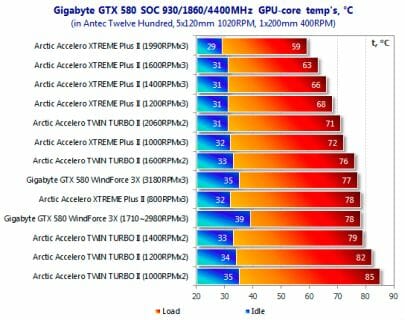
The Accelero Xtreme Plus II is still superior to its less advanced cousin, showing even stronger dependence of performance on the speed of the fans, which might be expected considering the high heat dissipation of the overclocked GeForce GTX 580. With a smaller heatsink and fewer fans, the Twin Turbo II finds it hard to cool this card and cannot cope with the task at 800 RPM. Anyway, it is superior to the original Gigabyte WindForce 3X cooler in performance and noise.
The Twin Turbo II couldn’t handle the FurMark load, so the GPU had to drop its clock rate.
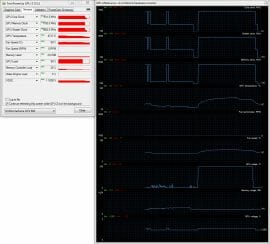
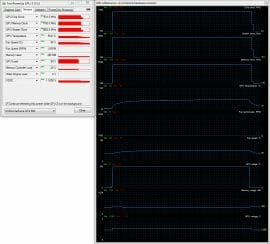
The Xtreme Plus II, on its part, passes this test successfully, the peak GPU temperature being 59°C. We dared not test the GeForce GTX 580 with its protection turned off.
Acoustic Performance
We’ll compare the noisiness of the new Arctic coolers with that of the MSI Radeon HD 6950 Twin Frozr III Power Edition/OC and Gigabyte GeForce GTX 580 1.5GB SuperOverclock. You can view the results in this table as well as in the diagram below.
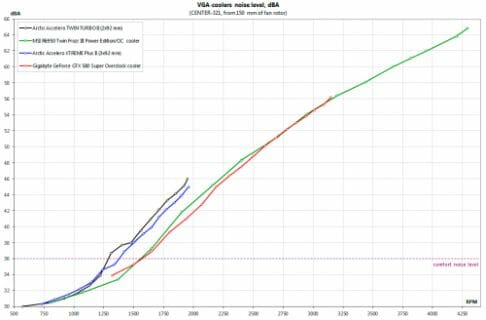

We can see that the maximum noise of the Arctic coolers is close to the minimum noise of the coolers from MSI and Gigabyte in 3D applications. Except for a small area of the diagram, the difference between the Twin Turbo II and Xtreme Plus II is negligible although the latter might be expected to be louder than the former due to the extra fan. The problem is that the massive plastic casing of the Twin Turbo II begins to resonate at a fan speed of 1200 RPM and higher whereas the Xtreme Plus II is free from that downside. Anyway, both coolers from Arctic Cooling are comfortable at speeds up to 1200 RPM and very quiet at speeds up to 1050-1100 RPM, which is enough to keep even a hottest and overclocked graphics card cool.
Conclusion
Arctic Cooling’s Accelero Twin Turbo II and Xtreme Plus II coolers have only one downside. It’s their high price. Even if your graphics card is as expensive as $300 and more, you may find the cost of these GPU coolers ($100 for the Xtreme Plus II or $66 for the Twin Turbo II) rather too steep. On the other hand, you won’t get such quiet cooling in both 2D and 3D modes with any original, let alone reference, cooler.
Besides the price factor, the fact that the hot air is not exhausted but remains within the system case can also be viewed as a downside, but this shouldn’t be a problem if your system case is well-ventilated.
Otherwise, the Accelero Twin Turbo II and Xtreme Plus II are blameless. They are highly efficient, quiet and compatible with a large range of graphics cards. They come with heatsinks, thermal grease and thermal glue included into the box and support PWM-based fan speed regulation. And all of this is capped by the 6-year warranty. Just a dream come true!